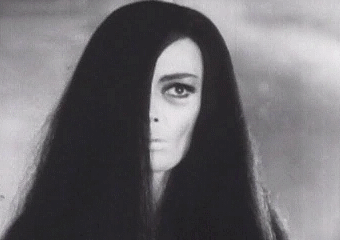
‘She is the only girl in films whose eyelids can snarl.’
— Raymond Durgnat
‘It must be tiresome being an icon, especially if you aspired to be an actor, not an image. “When did I ever deserve this dark mirror?” laments Barbara Steele, by telephone from Los Angeles. Hence, perhaps, her famed reluctance to discuss her role in Italian horror cinema. After all, she performed for Federico Fellini, Louis Malle and Volker Schlöndorff outside that disreputable genre. But the aura of dry ice and stage blood lingers in the cinematic unconscious, trailing her in gory wreaths.
‘Actors, like Barbara, who are always acting, are, of necessity, good at writing their own dialogue. In the course of a conversation about something innocuous – miscellaneous home repair, let’s say – she’ll slide, before you know it, into the syntax of an André Breton. Suddenly we’re discussing “a marriageable chair made from Van Gogh sunlight”, then the horror-con autograph shows, “moving into a Diane Arbus weekend”. And, “Flying at night – it’s like being a sperm again.”
‘Steele-speech is all startling word-images, evoking, say, the landscape around her Los Angeles home: “Coyotes come down the hill like perfect ghosts, walking like Nijinsky”; Paris: “Every encounter is a little love affair, including the dogs”; or Croatia: “Nocturnal medieval eels, swimming in the skull-infested Roman fortress, under the full moon in the inky sea”.
‘Steele talks compulsively about annihilation. “I feel it on a molecular level,” she says, drawing out ‘feel’ like a linguistic tendril.
‘From death of the self to the death of cinema: “Even if we’re going to make films, we’re not going to have cinemas,” she laments, but then you can almost hear those celebrated eyes widening as she adds, “I remember seeing my first film, and that was just the most staggering event. The usherettes with little trays of tea and biscuits. Errol Flynn was bouncing around in green tights. I remember going home to bed and thinking: ‘I have enough to think about for a whole year.’”
‘Some have tried to attribute Steele’s perceived ‘other-worldly’ quality to mixed ancestry, but she decries genealogy: “Who knows what anybody did under a mulberry tree in the spring of 1908 or 1808?”
‘In Basil Dearden’s Sapphire (1959), which Steele has never seen, the Rank starlet pops up as a London art student, but immediately vanishes: as fine as the film is, it’s hard not to want it to forget its plot and veer off to follow her bohemian adventures. “I had this Rank contract,” Steele recalls, “but I was still studying art history in London. They were very nice and let me get my degree, but they would put me into these films for one line.”
‘British cinema didn’t know what to do with her. Italy had ideas. The memory of arriving in Rome, “where everyone is singing an aria,” is still strong: “Here I am, English, and I felt I’d been born in the wrong place and the wrong temperature. And the moment I got to Italy it was like coming back to the essential womb…”
‘Black Sunday introduced full-blown gothic horror to Italian film, along with Steele’s sculpted visage, spidereyed and scarred with icky perforations created when a spiked iron mask is affixed by sledgehammer in scene one. From here in, there are two Steeles, the innocent live Katya and the resurrected witch Asa, a duality which will recur with dreamlike persistence in seven further Italian nightmares. Director Mario Bava, a cinematographer by preference, concentrated on atmospherics and let the cast get on with it.
‘“Bava was like a Jesuit priest,” recalls Steele. “I think he was profoundly shy. He certainly didn’t really direct his actors.” Bava cast Steele after seeing a spread in Life magazine, a choice clearly based not on experience but on physiognomy and lighting possibilities. My camera will like this face.
‘“Yes, but it’s always more than a face,” Steele insists. “It’s an energy. I know that film – I don’t know about tape – is like a succubus, it sucks in energy. Some people look magnificent, and they don’t have it, and they don’t galvanise you.”
‘With goldfish-bowl eyes radiating depraved elfin beauty, and what she calls her “old, suspicious Celtic soul” burning blackly within, Steele played the princess in a dark fairytale. “They sense something in me,” she once said of her fans, but surely it was true of her directors also. “Maybe some kind of psychic pain.” The diva dolorosa of the 1910s, reincarnated as voluptuous revenant.
‘Fortunately for Steele and cinema, her Italian sojourn also brought her into electrifying contact with another branch of cinema. “Fellini always claimed he never went to the movies,” she says, “so I do not know if he ever saw Black Sunday; what I do know is that my friend, the director Gillo Pontecorvo, told me he went one day on a hot afternoon to a tiny cinema in Trastevere that was deserted except for one person who was sitting in the back row – Fellini. I always wondered if the name Princess Asa in Black Sunday was related to the Magician in 8½, calling out ‘Asa nisi masa.’”
‘If Fellini’s ‘Asa’ was incantatory language for ‘Steele’, then banal distinctions separating genre horror from capital ‘A’ cinematic Art simply wither to nothing. Where auteurism once stood now rises a single human fulcrum balancing Black Sunday and 8½ (1963) – indisputable exemplars of presumptively distant worlds connected through an incongruous innocence. 8½ remains a living, black-and-white testament to the notion that Steele will forever be – in critic Raymond Durgnat’s shorthand for that now iconic moment when her smile beamed from beneath a black wavy-brimmed hat – “a modern girl”.
‘“The incredible thing is I had this psychic kind of foreknowledge that I was going to meet him [Fellini],” she recalls, still wondering at the strangeness. “When I was in Rome I told everyone: ‘Oh, I’m here to work with Federico.’ But I was like everybody else, I went into casting and I sat in one of those chairs. All of Rome was there, every dwarf, hooker and child was outside.”
‘Fellini described his creative process, whimsically or truthfully, as “sending for lots of ladies” and hoping the film would walk through the door, “maybe not all at once”.
‘“That’s how I met him, but he sent me immediately into costume fittings,” Steele says, growing increasingly animated, “and then I met the great [costume designer] Piero Gherardi, who was so exact. Half the priests in 8½ were women, you know, and he would cut their eyelashes. He was so precise about the little line of a mouth between the two lips… Anouk Aimée had the longest eyelashes, and he cut them all off for 8½…”
‘If Bava saw in Steele a sexy fright-mask, Fellini made more antic use of what she calls her “predatory bitch-goddess” image. Her character, Gloria Morin, embodies male mid-life crisis as the intended second wife of a secondary character. Sunny but somehow sinister. Her new/old partner boasts of her invigorating effect, but we expect her to slay him by infarction at any instant. Marcello Mastroianni’s film director Guido immediately casts her in his fantasy harem, and when the slaves revolt and he gets the bullwhip out, Gloria alone reacts with orgasmic relish to the hoopla.
‘More black masses followed, including two for Italian cult wizard Riccardo Freda: with plots that meld Poe with Gaslight (1940), Le Fanu with Les Diaboliques (1955), the films drift on dream logic. Torture chambers, desecrated tombs, necrophilia. The deletions of the censor merely add to the sense of demented unravelling.
‘“I adored Riccardo Freda,” says Steele. “He was prone to magnificent tantrums, which I really appreciated. I felt like we were in an opera. He had diabolical energy but also humour.” Freda had been Italy’s highest-paid director. Sliding out of fashion as neorealism caught fire, he laboured on regardless, through muscleman epics, horror films, spy capers and later gialli.
‘Freda’s The Ghost (1963)was scripted, shot and cut in a month, on a dare. In this and in his The Horrible Dr. Hichcock (1962), Steele is married to a Dr Hichcock, but it’s a different Dr Hichcock in each. And the films lack even internal continuity: you could surely splice them together at random so the characters would glide from one dungeon to the next, with no one the wiser.
‘“I know,” agrees their star, “and I would wear the same clothes in several movies. There wasn’t a single movie that took more than ten days to shoot. And we had very heavy, difficult equipment then, so it was quite an accomplishment for the crew, working 18-hour days. We would be so impoverished that if we didn’t have a dolly we’d just pull the camera on a carpet.”
‘Tarantino favourite Antonio Margheriti directed The Long Hair of Death (1964) and collaborated with Sergio Corbucci on Castle of Blood (1964). Assorted minor maestros gave us Nightmare Castle (1965), Terror-Creatures from the Grave (1965) and An Angel for Satan (1966), all of which still fascinate, revolving around Steele’s unmistakable star presence, which makes the wickedness alluring. Steele once spoke of infusing her gothic performances with erotic subtext. She says now, “It was something I instinctively knew: you should try to put out the energy of some kind of seduction.”
‘Steele saw her characters as embodying powerful, repressed and subterranean forces erupting into being and threatening the (male, Catholic) status quo, always ultimately destroyed to reassure the spectator who has been enjoying their demonic sprees a little too much… The undertones of misogyny would break through into Italian pop modernity in the later gialli thrillers, but ‘Steele gothic’ was always confined to the past, and to distant, dismal lands like Moldavia or England, insulating the transgressive elements.
‘Roger Corman snapped up Steele for his second Poe riff, The Pit and the Pendulum (1961) – she remembers him as “very young, very polite, a most unlikely filmmaker” – but why didn’t Hammer seek her out? “They did, but they were so disgusting,” she explains. “I mean that’s really like soft porn. I thought they were the creepiest things on the planet. Italian films were saved by the fact that we had these brilliant cinematographers and everyone was so visually conscious at that period. Light and beauty and shadow and violence… A grace and awareness comes off the Mediterranean. You dream differently.”
‘On the observation that there’s a sensuality in Italian horror that just isn’t there in the British and American films, Steele instantly responds: “Yes, well that’s British and American life.”
‘Steele worked only two days for British genre filmmakers: horned and painted green for Curse of the Crimson Altar (aka The Crimson Cult, 1968), and in Michael Reeves’s The She Beast (1966), where she was hired for a day and made to work 24 hours straight.
‘Marriage brought Steele back to LA, leading to work in early films by Jonathan Demme (Caged Heat, 1974), Joe Dante (Piranha, 1978) and David Cronenberg (Shivers, 1975). Steele remembers the bleakness of the wintry setting seeping into the mood of Shivers, though Cronenberg wooed her with flowers and was very focused and assured. She doesn’t recall slamming him against a wall when she mistakenly thought he was mistreating another actor (his story). “I don’t like the masculine quality of that,” she says: she prefers to think she’d have slapped him.
‘Then followed an unexpected move into producing, on epic miniseries The Winds of War (1983) and its sequel. “That’s just survival,” she says. “That went on for five years and it was very difficult. Eastern Europe, when they still had 40-watt light-bulbs, you know. And it was very difficult for me, because I was basically the only female and you don’t want to have vast crews in every country and they say, ‘What’s this woman doing here?’”
‘For decades, Steele was silent about her gothic career, an elective mutism partly in protest against the movies robbing her of speech: she was dubbed in most of them, even in the English-language versions. A slap in the iconic face, suggesting she was being hired as puppet rather than actor. They can be recalled now, though the feelings they inspire are, characteristically, turbulent.
‘“I’ve never had a good role, you know,” she says, more than once. “I’ve never, ever had a role powerful enough.” But she knows that her image as “dark goddess” was not mere audience projection – “It comes from within” – and has a vital connection to her true self: “I was made for horror. I don’t want to wear crinoline, I’m just a big blade.”’ — David Cairns, Daniel Riccuito
____
Stills


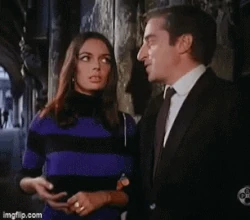
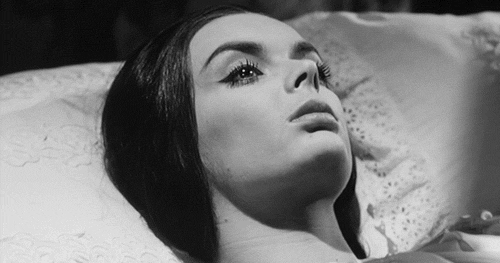
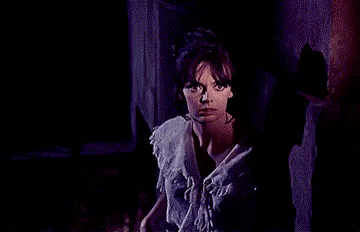
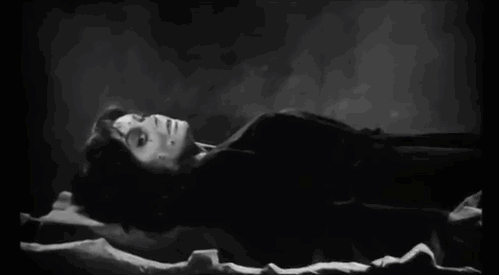
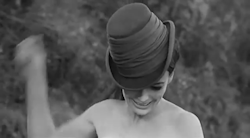
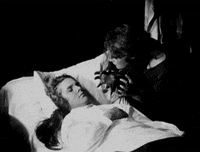


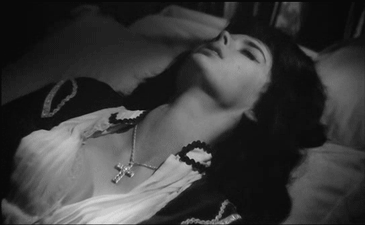
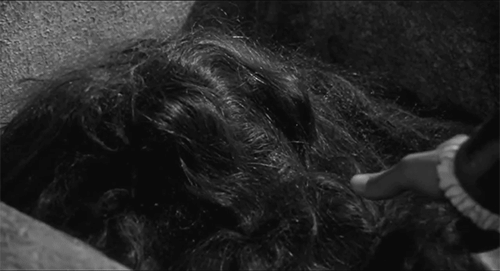

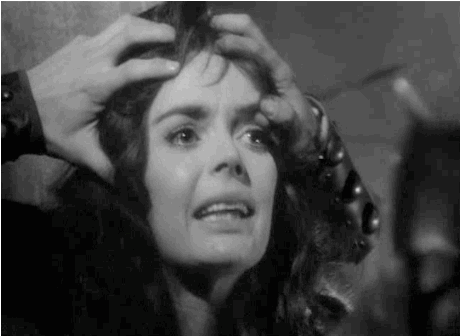
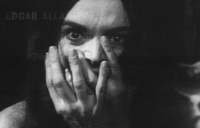

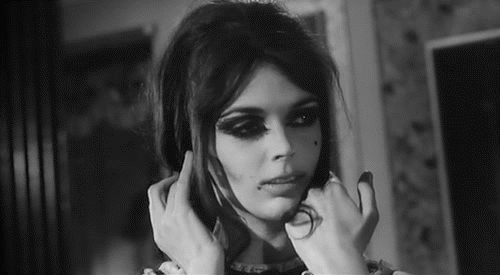
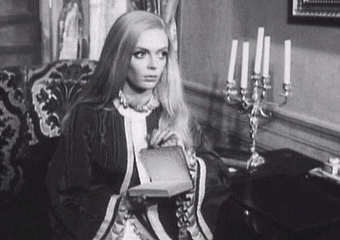
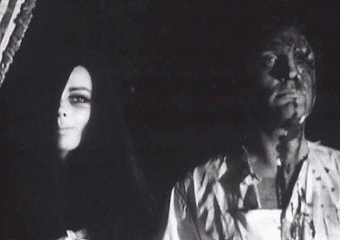

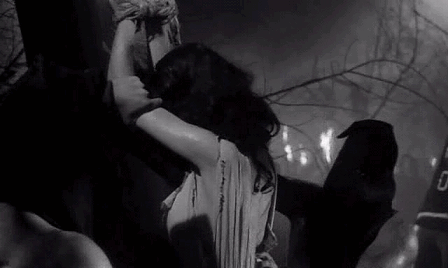

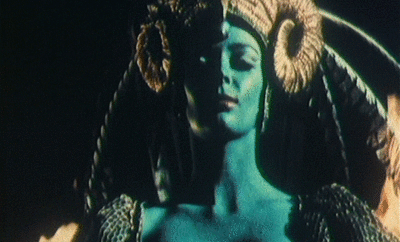
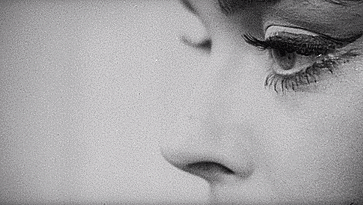
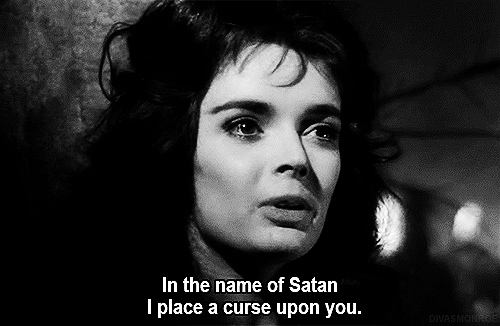







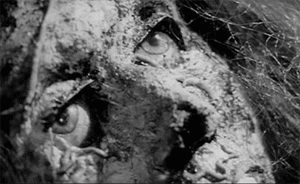
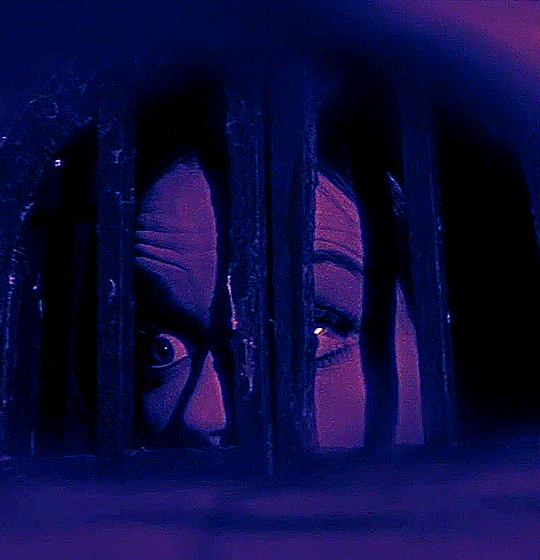
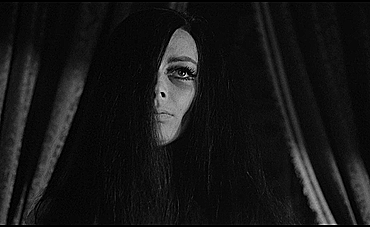

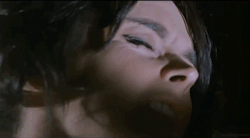
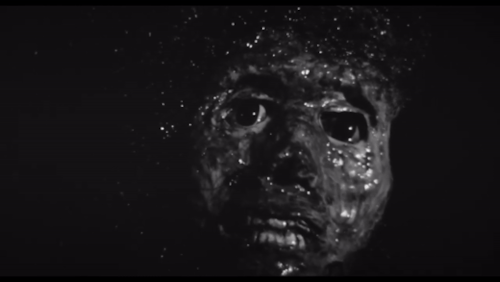
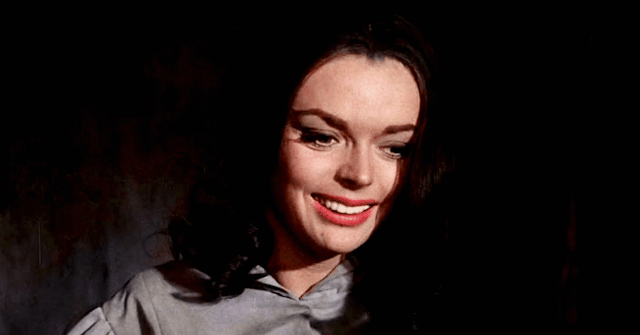
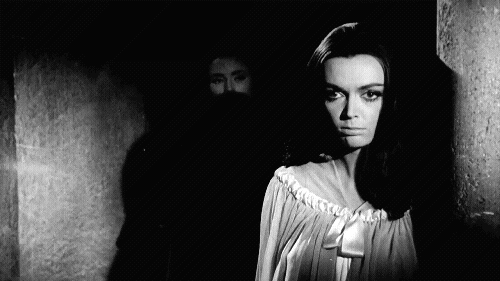
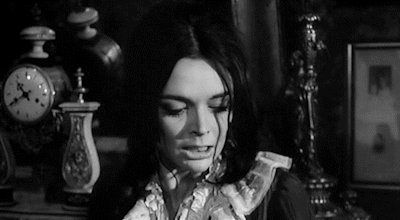
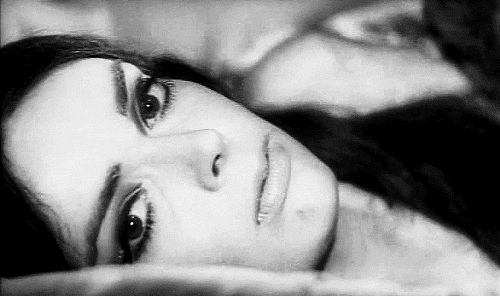
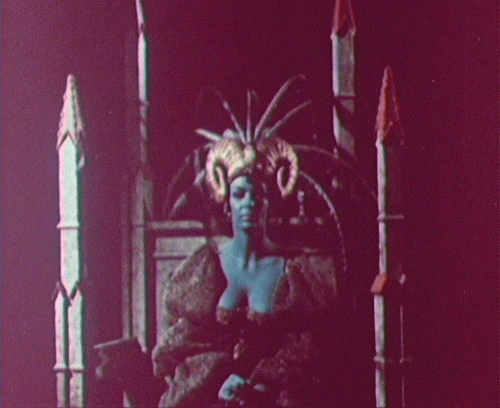
_____
Further
Barbara Steele @ IMDb
BS @ MUBI
The Barbara Steele Fan Page
“I was made for horror”
Barbara Steele: the accidental scream queen
Barbara Steele: Queen of the Italian Gothic Film
80 Glorious Years: “BARBARA STEELE in conversation with The House Of Freudstein.
Book: ‘Barbara Steele, An Angel for Satan’
____
Extras
Barbara Steele interview from the documentary Be Pretty and Shut Up!
Barbara and Her Furs (1967)
Barbara Steele – Interview 2009
Barbara Steele: The Ultimate Hammer Horror Supercut
_____________
Barbara Steele on working with Fellini
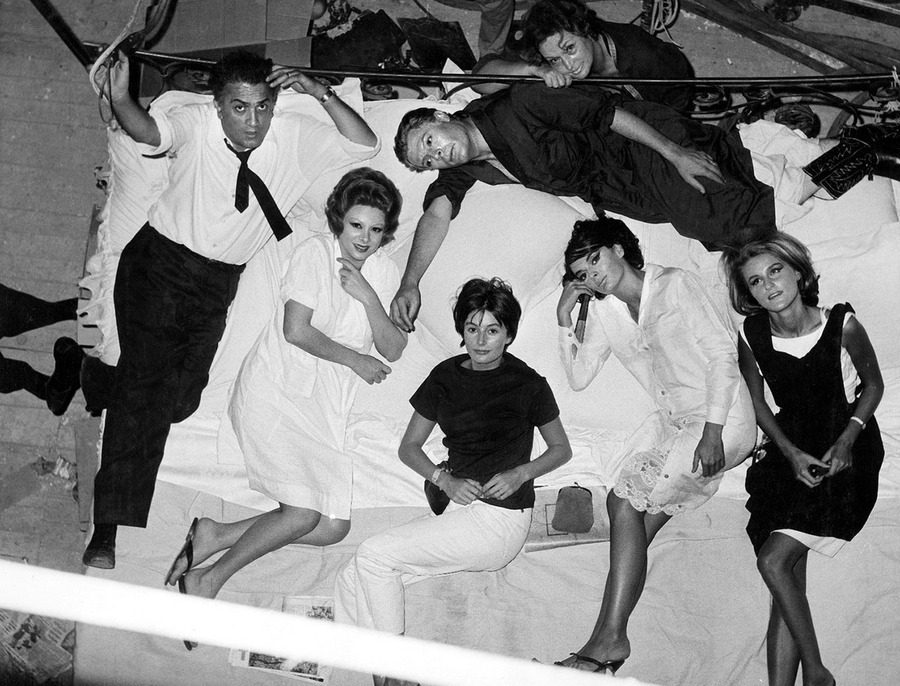
Arriving in Rome in 1960 was like flying straight into the sun. It was blazing, ripe, optimistic, feral, and fecund; enjoying a huge economic boom. It seemed to embrace everyone caught in its collective thrall.
It was a more intimate city then, still very Catholic, full of parades and rituals. Everyone ate at midnight. It seemed that no one ever slept, except during the siestas, when the city closed its eyes from two to six. Rome was charged with an erotic vitality and bursting with creativity. It was full of young painters and designers as well as amazing filmmakers: Visconti, De Sica, Rossellini, Antonioni, Pasolini, Monicelli, and Bertolucci… The emperor of them all, of course, was Fellini — the magician in the top-hat, the man with the golden whip.
The vast cult of celebrity and outrageous money had not yet revealed its Gorgon head. The paparazzi were like a hive of busy gossip-mongers, as much part of the scene as the street musicians and gypsies — we knew every one of them by name.
We were surrounded by 2000 years of ancient buildings and fabulous art. The Circus Maximus was still a thread that ran through everything. Even in the present moment, you were always connected to a deep past. Rome itself was an emotional and theatrical circus; the air full of perfume and desire, fabulous weddings, christenings, and funerals; a world filled with pageantry and ritual. Then there was this amazing light that surrounded us. Skies of such immense beauty and drama that you could believe they contained heavens within heavens. Fellini’s universe was filled with processions and parades — occult, mystical, generous, bestial, elusive, and full of the fantastical, of mythic Odysseys and solitude, composed with great tenderness. All of this was his own internal mythology. The deserted piazza, invariably seen at night in every Fellini film, that allows one to have an encounter with solitude and the soul; the wind another constant, and always a sense of space, the space of a dream, the internal space; and the eternal return to the sea, representing hope, the sea as mirror of the soul, the sea of departure, eternal, infinite.
La Dolce Vita, released in 1960, was like a prophecy for the upcoming decade. At first glance, both gorgeous and seductive, it was a bull’s-eye at interpreting the energy and atmosphere of that moment. But the subplot was one of self-loathing, decadence, and death.
8½ was Fellini’s masterpiece of beauty and guilt, anxiety and psychic terror. Like a fugue, it addressed the unconscious reality and the dream simultaneously. This was the last of his black-and-white films, and for me this was the end of an era, the end of his most personal and authentic films.
He saw all of Rome when he was casting. He received everybody like an emperor — anyone could get to see him then. He luxuriated in casting: he took four or five months on 8½ alone. He had a tiny little office, his walls seething with photographs of hundreds of faces and, to the exasperation of the producers, he was intensely interested in everybody. Casting was ecstasy and agony for Fellini because he was so intrigued with everyone he met. The corridor was filled with people waiting to meet him: immaculately dressed counts and contessas, butchers, nuns, ladies of the night, dwarves, one-legged men, women with babies, professors, journalists, actors, acrobats, gardeners, house-keepers, tutto-Roma.
This great bear of a man would meet you; his huge eyes totally focused on you, and out of this enormous fellow would come this tender conspiratorial voice, dolce and amused. Everyone who worked with him felt they shared a private secret with him — that he and he alone could mirror their souls like a great, slightly ironic Buddha.
I was very lucky; he sent me straight to costume fittings. No one received a script. We were merely given pages every day. Some kind of fabulous alchemy occurred out of this collective turmoil.
The shoot for 8½ was very joyful. We had a little 16-piece orchestra that would play for everyone, sometimes over dialogue, which was always looped in those days. We were all caught up in an atmosphere of abundance and love. We somehow unconsciously all knew that we were part of a fabulous dance, an extraordinary moment in time. With Fellini at the height of his powers, Rome felt like the centre of the universe.
Marcello Mastroianni would arrive for makeup in his striped pyjamas. He slept in his makeup chair while they poured espressos into him. Many times he would arrive in a horse-drawn carriage. They were available as taxis in those days. Occasionally, I would receive a phone call from Fellini at unexpected hours, usually in the middle of the night.
“Barbarini (his name for me), what are you doing?” “I’m trying to sleep,” to which he would reply, “Come for a walk with me, please.” And I would say, “Are you crazy, its 3:30am!”
Everyone who worked with him felt they shared a private secret with him — that he and he alone could mirror their souls like a great, slightly ironic Buddha.
And he would say, “It’s beautiful outside and I have umbrellas. We’ll go to the Appia Antica.” He was a nocturnal creature who loved to wander Rome at all hours of the night. So we would go to the Appia Antica, the storied road built by the Romans that leads like an arrow straight to Naples; the large paving stones still have chariot indentations on them in certain parts. And on some, huge penises are carved that apparently worked as arrows pointing the way to long-lost brothels of the Romans. Lined with massive dark cypress trees, it looked like a street of fate. On the right side were the ladies of the night, cooking sausages on sticks over little bonfires, all of them looking suspiciously like La Saraghina waiting for the early morning truckers. On the left the transvestites, pale and beautiful like apparitions from one of his movies. At dawn we would stop at a little cafe that would just be opening up. The owners always knew him and were thrilled to welcome him.
For me, the film Juliet of the Spirits was an apologia and mea culpa for his wife, for the long affair he had had with Sandra Milo. And then he made the extraordinary insult of putting her in the same movie. If you look carefully at this film you can see the face of Giulietta displaying such misery and sadness … I found it a very troubled movie.
Fellini hated working in colour. “It can never be authentic. . . It takes too long for the eyes to adjust in a darkened room to the brilliance of colour. It will never have the depth or the truth of black and white. If I shoot a scene of a stormy sea in black and white, the audience can project onto it their own experience of the ocean; if I shoot it in colour, it’s too literal and less emotional and effective.”
Fellini’s obsession with orgies, in La Dolce Vita, Satyricon, City of Women, Juliet of the Spirits and Casanova, were always extremely angst-ridden. In all of his narratives, this old Roman pagan desire inevitably ended in destruction and guilt. Years later, after I’d left Italy and was living in Malibu, I received a phone call from my old friend, Gore Vidal: “Ciao, Barbara – guess who I’m with? Federico!”
On that phone call, Fellini asked me to come to Rome for costume fittings to play the role, in Casanova, of a Venetian alchemist who, with her spells and potions, cured men of their impotence. I was personally thrilled; this was a sublime role and the most amazing costumes, with extraordinary and exotic headdresses, were made for me. But I could see that he was not happy with the thought of this project. “Why is he doing this?” I said to myself. “Is it some kind of spiritual exorcism?”
Six weeks into the shoot, and over budget, it was decided that a chunk of the script needed to be cut and along with it my part, before I ever stepped in front of the camera. I was never to work with him again. But I have many wonderful little letters with his beautiful little drawings on them. He was as Roman as the Coliseum. Sixty thousand people attended his funeral in 1993—five months later, Giulietta Masina died of a broken heart.
______________
22 of Barbara Steele’s 67 roles
______________
Mario Bava Black Sunday (1960)
‘In 1630, as a woman is executed for being a witch, she places a curse on those who condemned her. 200 years later, she returns from her grave and begins a bloody campaign to possess the body of her beautiful look-alike descendant. Now, only the girl’s brother and a handsome doctor stand in her way.’ — MUBI
the entire film
______________
Roger Corman The Pit and the Pendulum (1961)
‘Roger Corman’s The Pit and the Pendulum, starring Vincent Price (Nicholas Medina), is based on Edgar Allan Poe’s classic horror story, set in sixteenth-century Spain. The film opens with Francis Barnard (John Kerr) arriving at Nicholas Medina’s (Price) castle to investigate the death of his sister, Elizabeth (Barbara Steele), Medina’s deceased wife. Medina offers only a vague explanation as to the cause of her death, claiming she had become infatuated with the castle’s torture chamber. As Francis unravels the gruesome details of Elizabeth’s death he uncovers the secrets of Medina’s disturbing past. Each character becomes haunted by the ghost and corpse of Elizabeth, and Medina, on the verge of insanity, realizes his wife is not really dead.’ — Cannes
the entire film
_______________
Riccardo Freda The Horrible Dr. Hichcock (1962)
‘The year is 1885, and necrophiliac Dr. Hitchcock likes to drug his wife for sexual funeral games. One day he accidentally administers an overdose and kills her. Several years later he remarries, with the intention of using the blood of his new bride to bring his first wife’s rotting corpse back to life.’ — Letterboxd
the entire film
_______________
Federico Fellini 8 1/2 (1963)
‘Starring Marcello Mastroianni, Claudia Cardinale, Anouk Aimée, Sandra Milo and Barbara Steele, the film is about a harried movie director who retreats into his memories and fantasies. Being one of the most personal and introspective films of Fellini, the movie was a big international success, winning the Academy Award for Best Foreign Language Film in 1963 and appearing on many film critics’ lists of the best movies ever made.’ — Quartet
Excerpt
Excerpt
_______________
Riccardo Freda The Ghost (1963)
‘In the end, The Ghost isn’t as much about the creep factor as it is the thrill of seeing awful people get their comeuppance. And, in true Italian horror fashion, we find out there really may not be any heroes to be found in the film and that everyone will be given their just desserts. Ultimately, The Ghost doesn’t tread any new ground, as the French film Les Diaboliques had explored similar themes eight years prior. But if you enjoy watching bad things happen to bad people, then The Ghost will certainly scratch that itch.’ — Daily Dead
the entire film
_______________
Antonio Margheriti, Sergio Corbucci Castle of Blood (1964)
‘The living and the dead change places in an orgy of terror in Edgar Allen Poe’s story. A journalist takes a bet that he can spend the night in a haunted castle on All Hallow’s Eve. During his stay, he bears witness to the castle’s gruesome past coming to life before him, and falls in love with a beautiful female ghost.’ — Cult Cinema
the entire film
________________
Lucio Fulci I maniaci (1964)
‘Features a series of brief comic sketches based on manias, mainly sexual, featuring several figures of Italian society.’ — IMDb
the entire film
_______________
Antonio Margheriti The Long Hair of Death (1964)
‘Predictable, tedious and uninteresting black-and-white horror film that’s helped slightly by the presence of ‘scream queen’ Barbara Steele in a dual role. But this one is strictly for diehard fans of Steele, who must complete their collection with this unknown film. It’s about a witch accused of a murder she didn’t commit and is burned at the stake but puts a curse on the Humboldt family–the lecherous murderer of the witch’s daughter Helen, the Count (Jean Rafferty), and his evil son, Kurt (George Ardisson), the actual murderer of the crime the witch was accused of that sentenced her to death. Through her two daughters (one living-Mary, the other dead-Helen, both played by Barbara Steele) the witch gets revenge as during a plague she predicted, the witch is revived by lightning and comes up from the grave all pissed that her younger daughter has married the craven Kurt. In the end Kurt gets his comeuppance by being burned at the stake (which is apparent from early on that this will be how it ends and if you couldn’t guess that, then you should be punished by being made to watch the film again).’ — Dennis Schwartz
the entire film
_______________
Domenico Massimo Pupillo Terror Creatures From The Grave (1965)
‘Another of those Barbara Steele Italian horror movies. I guess it’s the dark black hair that always gets her cast as a heavy. She is always quite striking and a pretty good actress. This one is full of revenge, plague, and pestilence. Apparently, the lord of the manor has been mistreated or privy to the shenanigans of about five people and seeks revenge from the grave on them. One is his unfaithful wife, Steele. Each murder is set up in some bizarre way, each person murdered in an ugly, undignified way. Nobody in his right mind should still be in that castle. But it is quite scary and visually impressive. It’s worth an hour and a half.’ — Hitchcoc
the entire film
_______________
Mario Caiano The Faceless Monster (1965)
‘A definitely down-grade Barbara Steele vehicle, The Faceless Monster is a hastily cobbled potboiler that appears to have been assembled from ideas recycled from the Queen of Horror’s earlier pictures. The rushed and artless production doesn’t manage to do much more than keep Steele on screen about 90% of the time; it is overly complicated and numbingly slow.’ — DVD Talk
the entire film
_____________
Volker Schlöndorff Young Törless (1966)
‘Young Törless is to go to boarding school. His experiences there, the merciless torments of the pupils among themselves and the unsatisfactory answers of his teachers make it clear to Törless that good and bad cannot be differentiated in life. The boy leaves the boarding school at his own request after a short while. The incipient social and personal deformation in Musil’s novel is skillfully implemented by Schlöndorff in close correspondence with the text but also in a more distant manner.’ — oslri
Trailer
Barbara Steele – Volker Schlöndorff – Mathieu Carrière
______________
Michael Reeves She Beast (1966)
‘Barbara Steele was available for one day and is little more than a guest star but she helped to sell the picture. She’s only in it for the beginning and a few minutes at the end, but looks utterly gorgeous.’ — J Smith
the entire film
_____________
Camillo Mastrocinque An Angel for Satan (1966)
‘An Angel For Satan was the last of the Italian Gothics starring icy Goth queen Barbara Steele; handsomely directed by Camillo Mastrocinque (Crypt of the Vampire) who up a fever-dream of supernatural seduction and Gothic period atmosphere. Set in a lakeside Italian village in the 19th century Steele plays Harriet, the noble-blooded niece of Count Montebruno (Claudio Gora, Seven Blood-Stained Orchids) who has just returned home from college. In short order we learn that there is a family curse involving a beautiful Montebruno ancestor named Belinda (Steele in a dual-role) who was quite a bewitching beauty, she is said to have seduced all the men of the village. Her beauty was so great that a statue of her was sculpted and set to overlook the nearby lake. Unfortunately, her less attractive sister was none to pleased by her sister’s beauty and cursed the statue, and tragically died herself while pushing it into the lake.’ — MCBASTARD’S MAUSOLEUM
the entire film
_____________
Vernon Sewell Curse of the Crimson Altar (1968)
‘ “Crimson” shoots its cinematic load early–the film opens with a Satanic ritual, fully replete in chains, body paint and skimpy leather underwear, then transitions into an antiquing thriller–but the movie never stops trying. As soon as our hero starts investigating his missing brother, he runs into a flight of cars chasing a giggling woman who’s wearing a sheer unitard in what the film, with tongue firmly in cheek, calls a “sophisticated hide and seek.” When he gets directions from a strange after-hours gas station attendant, our hero arrives at the creepy lodge at the outskirts of town, which is hosting a Champagne-fueled swingers party with more body paint and underwear. To call this film a product of its time would be putting it mildly.’ — Idols and Realities
the entire film
_____________
Jonathan Demme Caged Heat (1974)
‘Compulsively watchable, which is probably the thickest thread that connects this to Demme’s later work. It’s funny, cool, socially conscious, and doesn’t fall in the nasty misanthropy quicksand that prison movies so often get sucked into – improbably enough, it even morphs into a road movie in the last third. VIP is Barbara Steele as the steelily unbalanced prison warden McQueen. If you ever wanted to watch a women-in-prison movie with a John Cale score, congrats, you can.’ — Joe
Trailer
______________
David Cronenberg Shivers (1975)
‘The film opens with an extended advertisement touting the benefits of Starliner Towers, the state-of-the-art apartment complex where virtually all of the subsequent action will unfold. Antiseptic in design and suffused with every technological advancement and accoutrement one could imagine, the place is like the architectural equivalent of one of those old Dewar’s Profile ads and you can practically see a copy of the current issue of Playboy sitting in full view on a coffee table in every single unit. While a young couple is meeting with the building’s manager (Ron Mlodzik) downstairs to sign a lease, something decidedly unsavory is going on upstairs. We then see a middle-aged man breaking into an apartment, beating and strangling the teenaged girl inside and then doing something particularly nasty to her body with a scalpel and a bottle of acid before slitting his own throat.
‘When the bodies are discovered, Roger St. Luc (Paul Hampton) is surprised to discover that the dead man is Dr. Emilie Hobbes, one of his former medical professors. Curious, he looks up Hobbes’ business associate, Rollo Linsky (Joe Silver) and learns that the two had been working on devising a new breed of parasite that could replace failed organs in the human body. As it is eventually revealed, Hobbes actually devised a parasite that was essentially part aphrodisiac and part social disease. He believed it would help mankind get more in touch with their basic primal feelings and he used Annabelle, who was his mistress, as an incubator. Unfortunately, Annabelle was also sleeping with several other residents and before long, the parasite has begun spreading throughout the building—in the most infamous example, one woman (the inimitable Barbara Steele) is taking a bath when the creature, unbeknownst to her, crawls up the drain and you can take it from there. Before long, the building is overrun with degenerate sex fiends attacking the rapidly decreasing numbers of the uninfected and while St. Luc, Linsky, and Forsythe (Lynn Lowry), St. Luc’s lovelorn nurse, try to find a possible antidote at first, the focus soon shifts to trying to escape before all is lost. You probably do not need to guess as to how well that turns out.’ — Peter Sobczynski
the entire film
______________
Louis Malle Pretty Baby (1978)
‘Barbara Steele played a supporting role in Paramount’s then-scandalous release Pretty Baby.’ — Brian’s Drive In
Excerpt
_______________
Joe Dante Piranha (1978)
‘The most unexpected delight in this movie for me was its absolutely unsubtle political messaging. I hits well for me, because I love a social-minded horror. One of the main targets of this film is the US military and the war+death complex. Turns out the ravenous, mutant killer fish were created by the US military to use against the Vietnamese. When the US were defeated and the war ended, the program was scrapped. The fish survived, because scientist Kevin McCarthy couldn’t bear to stop the good times and see his creations destroyed. Also of note, Barbara Steele is glorious as an absolutely terrifying military-adjacent scientist. When she stares right at the camera and says the film’s final line, “There’s nothing left to fear,” I felt that chill running up my spine.’ — cinema or whatever
Trailer
________________
Dan Curtis Dark Shadows (1991)
‘Barbara Steele played the roles of Dr. Julia Hoffman and Countess Natalie DuPres on the 1991 NBC Dark Shadows revival series. Her likeness was used to illustrate her respective characters in the various comic book series published by Innovation Comics. In the original Dark Shadows television series, the roles of Julia Hoffman and Natalie DuPres were played by Grayson Hall. In her portrayal of Julia, Steele spoke with her native British accent.’ — DSF
Opening credits
_______________
Edward L. Plumb The Boneyard Collection (2008)
‘How Barbara Steele, Tippi Hedren and Kevin McCarthy ever get roped into this disaster is beyond imagination. About a dozen interchangeable airheaded bimbettes self consciously struggle to get by on cleavage as they mumble, mangle and stumble through a witless, boring script. The various male players are likewise strictly Z-list rejects. None of them have a shred of acting talent or screen presence. Combine this with jittery steady cam videography, dimensionless lighting that only enhances the utter cheapness of the sets, and writing that beggars the expectation of anything approaching coherence, and you have The Boneyard Collection.’ — DoctorOod
Trailer
_______________
Chris Walsh The Shutterbug Man (2014)
‘Told in brilliant and haunting Stop Motion, the legendary Barbara Steele narrates the tale of “The Shutterbug Man.” With simplistic albeit immensely effective and haunting stop motion, Christopher Walsh tells us the tale of the Shutterbug Man, a local who spent his time taking pictures. He could only really take pictures of horrific sights and suffering as it granted him a sick pleasure.’ — Cinema Crazed
the entire film
_____________
Jake Scott Le Fantôme (2016)
‘This short is directed by Jake Scott (Welcome to the Rileys) and also starring Barbara Steele, Le Fantôme is an 8-minute film done for Ford Edge which finds Mikkelsen playing an assassin who gets diverted when he happens upon a new car. I bet that happens all the time.’ –– free car mag
the entire film
*
p.s. Hey. ** Dominik, Hi!!! So happy you like what you heard. Cool. Nice about the one day SCAB windfall. Hopefully they’ll make for excellent video game levels, haha. Already very excited for the new SCAB. Maybe we’ll get lucky and you’ll polish off the SCAB and we’ll polish off ‘Room Temperature’ at the same time. You’re still in Hungary. Or were at least, I guess. Long visit. It’s going to feel so good to settle back into your own abode. Let love add first class accommodation, free champagne, and a live unplugged mini-concert by your favorite band into the traveling equation today, G. ** _Black_Acrylic, Hi. ‘Rebound’ made it over to you, cool. I hardly know St Etienne. They’re one of my blank spots, which I will begin to fill in courtesy of that clip and, more importantly, your famously eagle ears. Someone named Il Discotto must surely be believed. Good weekend to you, Ben, and I hope you are evermore up and around. ** dooflow, Hey there, dooflow! Great to see you. Yeah, I saw Sebadoh a bunch back in the day, and they were very hit or miss live, which was kind of fun in and of itself. But, yeah, primarily a recording unit ultimately. How are you? I hope you’re doing great. ** Misanthrope, When I lived in Holland, I rolled my own. I remember liking doing it, but I seem to have no inclination to restart that practice. Also, when I was living in Holland, I used to shave using one of those brushes and cream sticks that you lather up to make the shaving cream, which I also really liked. Might try that again. Well, yeah, dipping sauce for the cheesy crust things, for sure. I have to go back to the blog on Monday, so I sort of feel you. Happy truncated one. ** seb 🦠, Hi. My week was … kind of quiet but perfectly okay. That sleep schedule is scary. Only to me, I have friends who sleep those hours, and it’s hell when you’re a morning person like me and need to ask them something. Ezra Blake, no, but I’ll search him out today. No, I try not to do least favorite lists, I think mostly because I hate arguing, especially on the blog, and when you put your favorites, people who disagree tend to be respectful of differences and stuff, but if you besmirch someone’s beloved something, they get pissed. So, no, and, honestly, I’d have to really think to think up my least favorite novels since I probably stopped reading them after a page or two. Do you have least favorite novels or whatever? I do like reading least favorite lists. Okay, opening the inevitably completely smashed package containing the now decimated and valueless precious godspeed-baseball and taking a teary-eyed selfie with it and texting it to you. ** tomk, Hey, Tom. I hope you end up liking them. At their best, they make and explore pretty fucking interesting sonic spaces and weird emotions, I think. Thanks, although let’s give it another several days before we celebrate the film thing because the money that would make the final stretch happen is not here yet despite hard promises that it would be. Same old. Great weekend! ** Bill, Yes, I will admit to having had something of a moderately big crush on Mr. Gaffney back then. ‘Birdboy’ looks like a thing. Where do you find these crazy, amazing things? Okay, I’ll see if I can score it somewhere. Thanks, pal. ** Darby 🐧, Penguin, no? And wonderfully odorless, if so. Yes, international mailing can be tricky. At least US -> France mailings. You know, probably the best thing to do is to send it to that LA address I gave you because its safety would then be mostly guaranteed, and I’ll be there in the next couple of months, and I can very carefully and elegantly wrap/protect what you send and place it in my carry-on luggage, and bring it home, and all will be well at only a slight delay. Does that make sense? ‘Stoner Witch’! I love The Melvins. Actually, I did a blog post of my favorite record albums of all time a couple of years ago, and I own them all, even if 90% of them are in my LA pad, and the list would probably change a bit if I did it today, but these were/are my favorite albums, if you really want to know. My favorite Cure album is ‘Pornography’. Nice weekend, you! ** Niko, HI there, Niko! I’ve been fine, and you? Oh, wow, yes, of course, I’d love to do the interview with you and for the Poetry Project. That’s very cool, and quite a an honor. Thanks! How should we set it up? Let me know, and let’s do it at your convenience. Thanks, Niko, and have a glorious weekend. ** Corey Heiferman, Hi, Corey. Yeah, even way up here, it’s so confusing about where the war is in its horrible trajectory, and being inside that trajectory … I’m just happy you sound like you’re making the best of it. No, I have no mental hurdles about my early-to-bed/rise schedule. I’ve always super prioritzed writing and making things over late night entertainment and partying and so on, which don’t really have much appeal to me. It did a bit more when I was drugging myself and drinking socially, but, even then, I always associated have clear headed mornings as key to making my stuff. So, no, not at all. You’re beset with concerns that you’d be a fuddy-duddy or something of that nature? Amazing about the guest posts. Wow, thank you! Really, either the link to the video or embed code is just fine. Most people send the links, and I set up the embeds on my end, but either works good. Really, that’s awesome, thank you, Corey!!! You so lucky on the sushi end. I don’t know what’s up with Paris. There are beaucoup vegan and vegan-friendly restaurants here otherwise. Excellent next pair of days to you, sir. ** Okay. I thought I’d give you all some fun this weekend in the form of mostly old school horror centered around the legendary Barbara Steele, so please go nuts with the offerings on hand or something. And I’ll see you on Monday.




 Now available in North America
Now available in North America 
Old School Horror with a glamorous leading lady… this Barbara Steele Day would be exactly what the doctor ordered.
Just when I thought my 2024 was off to a tricky start, yesterday my laptop died. My brother is coming round to give me a 2nd opinion but seriously it’s gone. Am writing this on my iPhone and will see you Monday x
Hey Dennis Hi! I’m back from 4 daze in Sedona vortex hiking and now I’m jazzed for these pilfer-worthy Barbara Steele gifs! While I was away, Paper magazine popped this story on today’s queer kids obsessing over Fear of Kathy Acker. https://www.papermag.com/fear-of-kathy-acker-revival . WTF. Story mentions many peeps including YOU! And one of those kids is Lily Lady whom I’m excited for you to meet soooon. They’re just a gem. Read anything good lately? I’m halfway thru new Ben Fama novel. I think it was on yr 2023 list. Love ya !!!!
Hi!!
I think this Barbara Steele day will be the perfect companion for a lazy Sunday spent in bed. Thank you!
Ah, that’d be so amazing – if the polishing off of SCAB and “Room Temperature” happened at (or at least around) the same time! How’s everything going? Have you heard back from any of the film festivals you submitted to?
Yeah, it was quite a long family holiday. I loved every moment of it, but it also feels nice to be back in Vienna – in our own space and all. (And love’s free champagne and mini-concert additions definitely made the journey fly by!) Love explaining how a small plastic flamingo ended up on our balcony while we were away, Od.
Hi Dennis! My name is Charlie and I’m an editor at The College Hill Independent—we’re an alt-weekly newspaper based out of Brown University and RISD in Providence, Rhode Island. I am a big fan of your novels and blog, and was wondering if you would be interested in being interviewed for the paper to talk about your work. Thanks and happy new year! =^)
A funny memory: I saw Sebadoh live in 1991, and they covered Tom Petty’s “Free Fallin’ .” A friend turned to me immediately afterwards and said “Lou Barlow writes such good songs.”
Did you hear the reissue of the Folk Implosion’s complete KIDS soundtrack?
New York was supposed to get a snowstorm this weekend – which would be our first in almost 2 years – but it’s just turned to rain. We’ll get another storm, with more rain, next week, but it’ll be even warmer then.
Hey Dennis, I just try to watch the movies that get good reviews from my friends. On that note, this was on Steve Erickson’s best of 2023 list:
https://letterboxd.com/film/rotting-in-the-sun/
It’s absolutely hilarious. And frightening.
I’ve seen a few Barbara Steele movies (other than 8 1/2). But her face and stills were so ubiquitous in the horror movie magazines I loved as a teen, I can’t tell which ones. For example, I’ve seen those images from Curse of the Crimson Altar so many times, but I’m sure I never saw the movie. I need to go through some of the movies and figure this out!
Bill
hi dennis! making this comment at 2am (terribly on brand for me) but i’m hoping i’ll nod off in the next half an hour or so. i only have a few books that i genuinely hate, and most of them are sequels. i know that ezra blake definitely knows who you are (there’s a chance they’re reading this blog, actually! if so, hi!!) based both on goodreads and their second book. i really like it when people decide to wear what influenced them with pride. getting to see the way in which an idea develops is always really interesting. maybe that’s why i’m so into this one game, spec ops the line? there’s a really clear line(ha!) from heart of darkness to apocalypse now to the game and i find it super interesting seeing different people with different experiences having completely different spins on the same story.
okay. going to *try* and sleep now (but no promises) and posting your sad selfie with the decimated remains of the godspeed-baseball online in the hopes that some kind stranger will help replace it.
im (maybe?) seeing tons of grammar mistakes(? maybe I’m seeing things as a result of my terrifying sleep deprivation) in this but for my sanity’s sake pretend that they’re intentional artistic decisions meant to make my commets cool and esoteric
@seb I’m a professional copy editor and your comment looks absolutely fine to me
Dennis, I’ve often seen those shave things and have been THIS close to trying them. I feel like I’d get a better shave. I’ll eventually try it.
Yeah, Monday blog blues. Or something like that. Haha. I’ve got a 3-day weekend next weekend because of the Martin Luther King Jr. holiday. Something to consider. 😉
I talked to Rigby for over 4 hours yesterday. That was fun. I’m planning on getting to London in July to see Suede. I want to see them in London. They’ll be playing at a park quite close to where Rigby lives in Haringey. That should be fun.
Oh ok as long as you can guarantee the package it’s safety then I think that will do
I will email u and let you know yada yada
Oh if you want you should totally check the email when you get a chance. I sent a picture you might find cool.
Bob Odenkirk is a brave stuffed kitten.
He gave me his eyes. He knew the risk and proceeded willingly. He is an honorable feline.
I will use him on the project I’m developing atm.
Barbara Steele, I wonder if Pete Steele took inspiration from her gothic visage And haunting gaze?
God that man is HUGE. I’m 2 FEET smaller than him. Although I guess I’m smaller than most people.
Ooh you have hooch? I saw (lll) crystal castles on the list and it reminded me to brag that I have (l) crystal castles record.
If we were in proximity living I would totally borrow/exchange records since I don’t know alot of people with records (oddly) and truthfully, my collection is puny and underdeveloped.
Have u ever owned a pet?
In 17th century France, Canicide (killing of dogs) was a rampant act due to to the fear of rabies disease and the ignorance to how it truly spread from its host.
Hi Dennis. Sharing some interesting art. At book signing in Vienna I recommended you a strange and fascinating html art website you may like. It has been online since the 1990s: https://mouchette.org/
Also wikipedia entry: https://en.wikipedia.org/wiki/Mouchette.org
I wonder if other directors would poach from Fellini’s casting line. I guess poaching the rejects would be the safest option. Thank you for all of the links to full movies. I haven’t watched movies in a while, gotta make more use of the rooftop setup.
My fuddy-duddy concerns about early-to-bed-early-to-rise have totally dissipated after I ran into a dashing acquaintance early yesterday morning. If both you and he are up early it can’t possibly be uncool. I’m happy with the new schedule. My mood is better and everything is easier to do.
What is/was your relationship to Marco Vassi, the man and and the work? I’m reading “Mind Blower”. It exactly matches my current wavelength. I see you gave a nod to “The Stoned Apocalypse” in a post about LSD literature from 2018. If you happened to make a Day for him in the old blog I’d greatly appreciate a revival.
Hey, glad to hear you’re doing good, I’m fine too! I sent you an e-mail about the Poetry Project interview with a few date suggestions for January, I just wanted to give you a heads-up over here on the blog, since I know catching you via e-mail can sometimes be tricky.